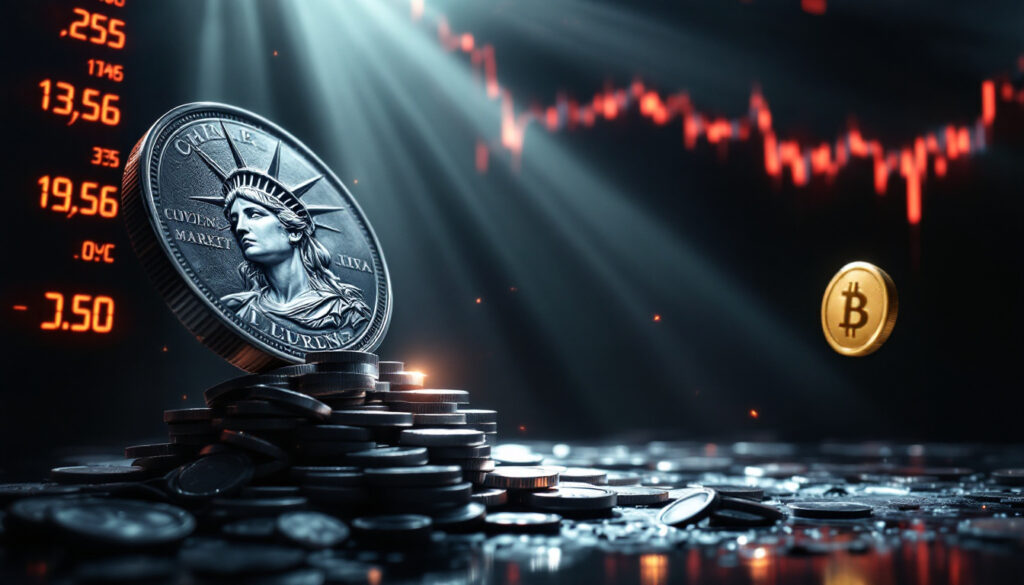What Caused the Recent Silver Market Crash?
Unprecedented Price Drop and Market Conditions
Silver investors witnessed a shocking 20% price decline in less than two days, creating ripples throughout the precious metals sector. This dramatic sell-off wasn't isolated to just silver but extended across multiple commodity classes. Copper tumbled 10% while crude oil plummeted 15% during the same timeframe, indicating a broader economic shift rather than targeted manipulation in precious metals.
The comprehensive nature of this silver market downturn suggests deeper macroeconomic forces at work. According to market analyst Chris Vermuan, "When we see simultaneous selling pressure across diverse asset classes, it typically signals a fundamental reassessment of global economic conditions rather than isolated sector-specific concerns."
Tariff Increases as a Trigger
A primary catalyst for this market turmoil appears to be the unprecedented tariff increases implemented by US President Trump. These new Trump's commodity policies have reached historically significant levels—potentially exceeding even those of the infamous Smoot-Hawley tariffs during the Great Depression. The magnitude and suddenness of these policy changes caught markets completely off guard.
The implications are far-reaching: Chinese imports will become substantially more expensive for American consumers, potentially triggering inflationary pressures while simultaneously restricting consumer spending power. This economic double-bind created immediate uncertainty in markets globally, with silver bearing a disproportionate brunt of the selling pressure.
How Does the Technical Analysis Look for Silver?
Chart Pattern Analysis
From a technical perspective, silver had been displaying a classic "staircase" pattern that seasoned traders recognize as a warning sign. This pattern manifests as slow, grinding upward movements followed by rapid, elevator-style drops. Prior to the crash, silver made three distinct surges to a high point—a bearish pattern on weekly timeframes that suggested exhaustion among buyers.
Most significantly, silver had reached its 100% Fibonacci measured move before experiencing rejection and subsequent collapse. The breakdown below the 150-day moving average—a critical technical indicator watched by institutional investors—further accelerated the downward momentum as algorithmic trading systems triggered automatic sell orders.
Support and Resistance Levels
Technical projections suggest silver could potentially fall to the $24-26 range before finding substantial support. The metal is approaching significant historical support levels but market dynamics insights indicate it may not have discovered its ultimate bottom yet. The 618 Fibonacci retracement level served as a formidable resistance point that silver repeatedly struggled with before the collapse.
As veteran precious metals trader Michael Stall notes, "Silver's extreme volatility compared to gold makes technical support levels less reliable during periods of market panic. We often see overshoots below logical support before stabilization occurs."
How Does This Compare to Previous Market Downturns?
Similarities to March 2020 COVID Crash
The current silver plunge bears striking resemblance to the March 2020 COVID-related market crash in both severity and velocity. During that historic downturn, silver initially sold off aggressively along with other risk assets before the Federal Reserve intervened with trillions in monetary stimulus packages.
The market environment today may eventually warrant similar intervention, though timing remains uncertain. Key differences include the inflationary backdrop that didn't exist in 2020 and central banks' diminished capacity to implement QE programs without risking further price increases in consumer goods.
Capitulation Selling Indicators
Extreme capitulation indicators emerged during this sell-off. The NYSE showed an unprecedented 45 shares being hit on the bid for every 1 share bought on the ask—a remarkable ratio that signals panic-driven liquidation. For context, readings above 3 typically indicate panic selling; the current reading of 47 demonstrates extraordinary fear levels rippling through markets.
This panic selling affects all asset classes regardless of underlying fundamentals. Even traditionally defensive dividend stocks declined approximately 4%, demonstrating how indiscriminate selling becomes during periods of maximum fear in markets.
Why Is Gold Performing Better Than Silver?
Gold's Relative Stability
While silver suffered a catastrophic 20% decline, gold demonstrated significantly more resilience, falling only 5% over three trading sessions. This performance gap highlights gold's status as a global barometer of monetary confidence and its tendency to maintain relative stability during extreme market dislocations.
"Gold functions as the senior precious metal for good reason," explains commodities strategist Rebecca Chen. "Its larger market capitalization, central bank holdings, and psychological importance as the ultimate monetary metal provide buffers against volatility that silver simply doesn't possess."
Gold's Technical Picture
From a technical standpoint, gold reached its 100% Fibonacci measured move at approximately $3,200 before experiencing rejection. The metal had hit long-term targets based on the 2011 high and 2015 low—significant multi-year reference points for institutional investors.
Despite the recent pullback, gold market analysis shows its chart structure maintains considerably more integrity than silver's. The higher-lows pattern remains intact on monthly timeframes, whereas silver has violated multiple support levels, damaging its technical health in the intermediate term.
What Investment Strategies Should Be Considered?
Avoiding Bottom-Picking
During sharp market drops, the natural human tendency is to attempt identifying bottoms—a strategy that often proves dangerous and costly. Rather than trying to perfectly time market nadirs, prudent investors should await clear technical signals indicating stabilization.
The reality is stark: maintaining a cash position of even 4% dramatically outperforms unsuccessful attempts at timing market bottoms that result in further losses. As the market adage goes, "Don't try to catch falling knives"—an especially relevant warning during periods of extreme volatility in metals markets.
Dollar-Cost Averaging Approach
A more sustainable approach involves dollar-cost averaging—purchasing small amounts regularly over extended timeframes rather than making large one-time investments. This methodology effectively averages out the highs and lows inherent in volatile markets like silver.
This strategy proves particularly effective when the long-term fundamental trend remains positive despite short-term volatility. Many global commodity insights maintain bullish long-term outlooks based on industrial demand growth and monetary debasement concerns, even while acknowledging significant near-term downside risks.
Potential Market Timeline
Market veterans project a potential short-term bounce followed by continued selling pressure as institutional positioning adjusts to the new economic reality. The most likely scenario involves a multi-month consolidation period before a more definitive directional move emerges.
More concerning for traditional investors is the possibility of a "lost decade" for returns in conventional buy-and-hold strategies. Historical precedent suggests that following severe market dislocations, extended periods of subpar returns often follow as valuations normalize and economic fundamentals reassert themselves.
How Might This Affect the Broader Economy?
Recession Indicators
The tariff increases that triggered the silver sell-off will likely produce ripple effects throughout the broader economy. Higher import costs inevitably slow business activity as profit margins compress and consumer purchasing power diminishes.
The market appears to be discounting a meaningful recession rather than continuing the "kick the can down the road" approach that characterized much of the post-2008 era. This realistic pricing of economic risk marks a significant departure from the optimistic market sentiment that prevailed before the silver market downturn.
Energy Sector Implications
Oil breaking below the critical $65 per barrel support level signals potential trouble for the energy sector. Energy stocks likely face significant downside risk—potentially 20-30% from current levels according to sector analysts.
This energy weakness holds particular importance for dividend-focused investors, as many high-yield portfolios maintain substantial allocations to energy companies. The combination of price declines and potential dividend cuts could create a perfect storm for income-oriented investors who viewed energy stocks as safe havens.
What About Technology and Growth Stocks?
Magnificent Seven Outlook
Major technology stocks are showing concerning signs of significant market tops. Companies comprising the "Magnificent Seven" group that dominated market returns in recent years exhibit technical patterns suggesting exhaustion of buying pressure.
Retail investors holding these names face potential continued selling pressure as momentum reverses. The pattern resembles the long-term decline seen in marijuana stocks after their speculative peak—a slow, grinding downtrend punctuated by periodic relief rallies that ultimately fail.
Perhaps most startling is analyst Chris Vermuan's specific downside target for Nvidia at $64—representing a catastrophic decline from recent highs. While controversial, this projection reflects the extreme overvaluation that characterized certain technology segments before the market reversal.
FAQ About the Silver Market Downturn
Is this silver price drop due to manipulation?
The current silver price decline appears to be part of a broader market selloff rather than isolated manipulation. With copper down 10% and crude oil down 15% during the same period, the evidence points to widespread risk-off sentiment affecting multiple asset classes simultaneously.
Silver's smaller market size makes it particularly susceptible to volatility when institutional investors reposition portfolios during periods of economic uncertainty. While manipulation certainly exists in precious metals markets, the current price action more likely reflects legitimate macro concerns rather than targeted suppression.
When might silver prices recover?
While short-term bounces are likely given the oversold technical conditions, meaningful silver price recovery may require months rather than weeks. Technical analysis suggests potential continued pressure before establishing a solid bottom, with support in the $24-26 range potentially providing a foundation for eventual recovery.
Market history indicates that metals often experience secondary declines after initial crashes as latecomers finally capitulate. Investors should prepare for a potentially extended basing period before sustainable uptrends emerge, particularly if global economic conditions continue deteriorating.
Should investors buy silver at these lower prices?
Rather than attempting to identify the exact market bottom—a notoriously difficult endeavor—a dollar-cost averaging approach offers superior risk management. The silver market appears to be transitioning between regimes, potentially creating further volatility before establishing clear direction.
Long-term silver fundamentals remain supportive given industrial demand growth in green technologies and persistent sovereign debt concerns. However, near-term headwinds including dollar strength and potential deflationary pressures could create additional downside before these fundamentals reassert themselves.
How does silver's performance compare to gold during this downturn?
Gold has demonstrated remarkably greater stability during this market dislocation, falling only 5% compared to silver's 20% decline. This significant performance gap reinforces gold's status as a more reliable store of value during periods of extreme market stress.
The gold-to-silver ratio has consequently expanded dramatically, approaching levels typically seen during major economic crises. Historically, such extreme ratios have eventually normalized, suggesting potential for silver outperformance once markets stabilize—though timing such reversals remains challenging for investing vs speculating strategies.
Ready to Spot the Next Major Mining Discovery?
Stay ahead of the market by accessing real-time alerts on significant ASX mineral discoveries through Discovery Alert's proprietary Discovery IQ model, which transforms complex mineral data into actionable investment insights. Understand why historic discoveries can generate substantial returns by visiting Discovery Alert's dedicated discoveries page and begin your 30-day free trial today to position yourself ahead of the market.




